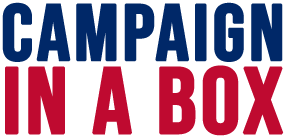Building Your Campaign’s Digital Library for a Winning 2025 Strategy
Create clarity, consistency, and speed across your campaign team.
Introduction
Running a political campaign today means managing endless files, scripts, and updates. A campaign digital library solves that chaos. It gives your team one place for everything — from talking points to volunteer scripts — and keeps everyone on the same page.
In this guide, you’ll learn how to build a campaign knowledge base that unifies your message, protects your data, and helps your team win through organization.
Why Every Campaign Needs a Digital Library
A campaign digital library isn’t about storing more documents — it’s about reducing confusion.
When your field team, comms, and finance staff all work from the same system, mistakes drop and momentum grows.
Key Benefits
-
Faster onboarding for new staff and volunteers
-
Consistent messaging across all channels
-
Protected donor and voter data
-
Less rework and duplication
-
Easier compliance and reporting
Clarity is a campaign strategy — and your library is where it starts.
Step 1: Build a Strategic Overview Section
Start with a simple “Welcome Hub” that orients anyone joining your campaign.
Include your mission, values, and top policy priorities written in plain, memorable language.
What to Add
-
Candidate bio and vision summary
-
Chain of command (who approves what)
-
Brand guide: tone, color, and voice
-
Quick video message from the campaign manager
This section ensures every team member knows what you stand for and how to represent you.
Step 2: Organize Campaign Operations
Your operations section standardizes daily execution — so no one has to guess how to run an event or send a briefing.
Include Templates For
-
Event setup and run-of-show checklists
-
Volunteer shift procedures
-
Daily briefing notes
-
Crisis escalation contacts
Consistency frees your team to focus on strategy, not logistics.
Step 3: Create a Message and Policy Center
Messaging discipline wins trust.
Centralize your approved talking points, bios, and Q&A sheets so every spokesperson and volunteer speaks with one voice.
Store These
-
Issue talking points (3 per topic)
-
Debate prep and media Q&As
-
Crisis communication guidelines
-
Social media response playbook
When your words match your values, voters feel it.
Step 4: Centralize Outreach and Communications
Keep your campaign’s voice unified across email, text, and press.
Break It Into Three Folders
-
Email Marketing – templates, tone rules, and approval process
-
Text Messaging – compliance scripts and GOTV reminders
-
Press and Media – releases, interview requests, and media contact lists
A consistent outreach DNA builds professional credibility with supporters and journalists alike.
Step 5: Protect Compliance and Donor Trust
Fundraising mistakes can damage your reputation.
Your Treasury and Fundraising section should outline what’s allowed, track donations, and provide thank-you templates.
Include
-
Contribution limits and rules
-
Event fundraising checklist
-
Donor thank-you scripts
-
FEC reporting schedule
Professionalism earns donor confidence — and repeat support.
Step 6: Manage Volunteers and People
Volunteers are the backbone of every campaign. A clear onboarding process helps them perform confidently.
Add
-
Volunteer handbook and safety policy
-
Code of conduct
-
Canvassing and phone banking scripts
-
Recognition and reward list
Empowered volunteers amplify your message and culture.
Step 7: Secure Data and Technology
Every campaign must protect sensitive voter and donor data.
Define Rules For
-
Access permissions by role
-
Password and device security
-
Backup and recovery process
-
Approved apps and AI tools
Data security isn’t optional — it’s leadership in action.
Step 8: Standardize Collaboration and Projects
Internal communication breakdowns kill productivity.
Use one shared system for project updates, task ownership, and deadlines.
Include
-
Project creation guide
-
Weekly status template
-
Slack/email etiquette rules
-
Meeting scheduling checklist
Structure builds rhythm and accountability.
Step 9: Build a Crisis Response Section
When something goes wrong — a misquote, an attack ad, or a leak — your team should know what to do immediately.
Add Protocols For
-
Media misquotes and corrections
-
Negative social comments
-
Legal and compliance issues
-
Spokesperson approval
Confidence in crisis comes from preparation.
Step 10: Maintain a Media Asset Library
Keep all brand assets in one place to protect visual consistency.
Organize
-
Logos, fonts, and headshots
-
B-roll and press photos
-
Flyer and sign templates
-
Expiration dates for outdated designs
Visual consistency builds recognition and trust with voters.
Maintaining Your Campaign Library
Your digital library only works if it stays current.
Assign section owners (operations, comms, field, finance) and schedule quarterly updates.
Train new hires using the library — teach them to find answers before asking.
Conclusion: Clarity Wins Elections
The strongest campaigns don’t just out-message opponents — they out-organize them.
A campaign digital library turns chaos into clarity, making your team faster, more consistent, and ready for any challenge.
When your campaign runs on clarity instead of confusion, every action becomes a step toward victory.

